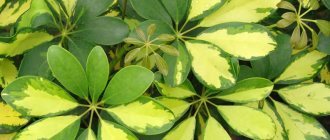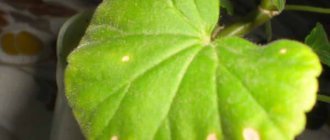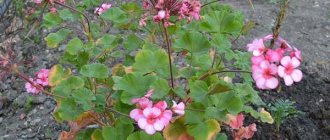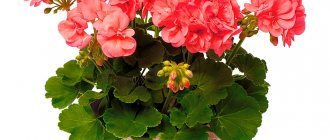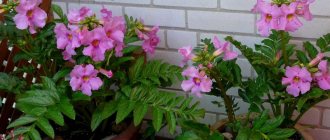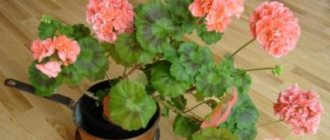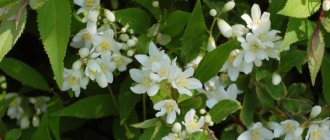What determines the fluffiness of geraniums?
Flower growers value geranium, also called pelargonium, for its unpretentiousness, abundant flowering and decorative appearance. When growing it, it is important to know the peculiarities of flower formation: how to prune pelargonium to get an attractive fluffy bush with abundant and long-lasting flowering.
There are several important factors in care that determine how decorative and fluffy a flower will be.
Firstly, this is lighting. Geranium is a light-loving crop. If you do not take care of it and grow it in a lack of light, the lower leaves fall off, the branches begin to stretch strongly, and the stem becomes bare.
A sufficient amount of nutrients during the growth period is an important factor in care. It plays a significant role in the growth of green mass and the formation of a well-leafed fluffy bush. With a lack of microelements, the growth of pelargonium may slow down, the leaves turn yellow and fall off.
The third and most important factor is proper crown pruning. It is necessary to prune pelargonium, as this care procedure allows you to awaken dormant buds and get a fluffy bush. Pruning is also important for setting inflorescences and abundant flowering.
Why and when is pinching needed?
Geranium, or as it is also called pelargonium, is a perennial plant that blooms long and luxuriantly. The flower has many medicinal properties and is practically not afraid of insect pests, which it repels with its specific smell. We find geraniums not only in gardens and flower beds, but also on many window sills. Thanks to its unpretentiousness and beautiful flowering, geranium has gained great popularity in our country. But so that this beautiful flower remains compact and attractive. And it didn’t take up half the window sill; it needs to be properly looked after, pinched and trimmed in a timely manner. By using these simple geranium shaping techniques, you will achieve two important goals:
Using hedgehogs to process potatoes
Types of seedling cassettes and their use
Hazelnut - how it grows and blooms, growing a nut in the garden
- Timely pinching will allow the plant to bloom beautifully and profusely.
- In addition, pruning and pinching pelargonium will rid the plant of diseased and weak branches that slow down the growth and development of the flower.
- Pinching delays the flowering period of geraniums, since the nutrients that should be supplied to the upper growth point are spent on the formation of new side shoots. Therefore, this procedure can be used as a regulator of the flowering time of a flower. You need to stop pinching the plant after it has acquired the desired shape and bushiness.
What does geranium need for fluffiness?
To get a decorative fluffy geranium bush, it needs to be pruned according to certain rules in spring and autumn. This care procedure stimulates active growth and lush flowering of pelargonium, as the buds on the sides of the main shoots are activated and flower buds are formed.
When caring for a flower throughout the growing season, it is necessary to pinch the side branches above the 4th leaf node; if there are too many of them, remove some of them.
What to do to make the bush grow thicker?
On a note. In order for geranium to grow into a lush bush, its apical bud on the main shoot above the stem node must be pinched.
This stimulates the growth of lateral buds on the lower nodes of the stem. After this event, the seedlings will slow down their growth , but will begin to gain strength. The geranium will eventually take on a beautiful spherical shape due to the appearance of many side stems.
How to prevent the flower from stretching too much upward?
To prevent geraniums from stretching out, pinching should be done at the most important upper point of stem formation. If after this procedure the shoots begin to grow again from the upper axils of the leaves, they must be removed, then allowed to grow a little and pinched back again. During this time, the buds are removed so that the flower devotes all its strength only to the growth of side shoots.
What to do for lush flowering?
Only young shoots bloom in geraniums. Therefore, in order for it to develop quickly and bloom luxuriantly, young shoots must be pinched after the formation of the first 4-5 pairs of leaves. As a result, the remaining strong shoots will begin to actively grow and develop, turning into a lush crown with many flowers.
How to care for geraniums so that they are fluffy
In order for geraniums to be fluffy, they must be properly cared for from the very beginning of cultivation.
When planting geraniums, you need to choose the right size pot. Experienced gardeners do not recommend planting this flower in large containers, as it will not grow and bloom well until the roots have filled the entire volume of the pot.
Geranium comes from the arid regions of Africa, so it can hardly tolerate stagnant moisture. You need to take care of it in such a way that it is better not to top it up slightly than to overfill it. But in summer, on hot days, moisture evaporates more intensely, so it is recommended to increase watering.
Care is as follows: water only with warm water; cold water will cause stress in the pelargonium and cause leaves to fall off. Also, pelargonium does not require spraying; frequent contact with water on the foliage can cause it to turn yellow.
It is recommended to fertilize every two weeks during the growth period. You can use ready-made fertilizers for indoor flowers, apply according to the instructions.
How to prune geraniums to make them fluffy, step by step photos
You need to prune geraniums to form a bush according to the following scheme:
- Examine the plant in order to understand which branches stand out from the general mass, are too long, crooked or thin, and what shape you would like to give the flower.
- Prepare cutting tools. They should be sharp; you can use a knife with a thin blade or a scalpel. It is not advisable to trim with scissors, as they squeeze too much when cutting and damage the tissue of the stems. Treat instruments with alcohol or other antiseptic to prevent pathogenic microflora from being introduced into the sections.
- If there is withered and dry foliage, trim that too. Trim all uneven and damaged branches. Weak side branches need to be pruned, since a bush that is too thick is also bad. Leave only strong, healthy shoots.
- If there are small short shoots on the sides at the base of the remaining shoots, then they should be trimmed. Trim long main shoots to 1/3 of their length, and trim secondary shoots at the level of the 4th or 5th leaf node.
- Sprinkle all cutting areas with charcoal powder. If you don’t have it, you can replace it with crushed activated carbon tablets. 3-4 days after pruning, it is advisable to feed the geranium with fertilizer containing nitrogen. This feeding will help the geranium recover and increase its green mass.
ATTENTION! To form a fluffy bush, one-time pruning is not enough. You need to take care often and, most importantly, regularly. During the entire growth period, it is necessary to monitor the growing branches and periodically pinch them at the level of the 4th bud.
Preparatory work before pruning
Before you start pruning, prepare:
- A sharp instrument. It is convenient to trim the stems with a stationery knife. But it’s better not to cut geraniums with scissors - they will pinch the stems at the cut site.
- Disinfectant. Treat the cutting tool with it. Alcohol or vodka is suitable for disinfection. You can simply boil the tool - 5 minutes is enough. Disinfection will prevent infection from entering wounds.
- Silicone gloves. Wash your hands with soap and wear gloves to avoid infection.
- Coal. Sprinkle the cuts with charcoal. This will promote wound healing.
Before pruning, remove dried and yellowed leaves.
How to choose the time to prune geraniums
You can prune geraniums in spring and autumn. Spring pruning is considered the main thing in care, since it is it that allows the bush to form a fluffy shape and stimulates lush flowering. It is carried out immediately after winter, as soon as daylight hours increase, usually from the end of February to mid-March.
IMPORTANT! When pruning in spring, you cannot prune more than 1/5 of all shoots, since with such a radical approach, flowering may occur only closer to autumn or in the next season.
To maintain a beautiful geranium crown, during the entire growing season it is necessary to carry out a care procedure such as pinching. It consists in removing the upper growing point, which forces the geranium to produce lateral shoots. It is thanks to pinching the tops that the fluffy shape of the geranium will be preserved.
Autumn pruning can be called sanitary. It is carried out in October, after flowering. It consists of removing dry peduncles, branches and leaves, and shortening excessively long shoots.
If the flowers spent the whole summer outdoors, then in the fall you need to bring them indoors and give them a couple of weeks to adapt. Only then prune, otherwise the geranium will experience stress and may get sick.
How to do it correctly?
The algorithm of actions here is as follows:
- Before pinching, carefully examine the upper shoots of the flower and find the growth point on them, the largest upper bud of the shoot, which is responsible for the active growth of the plant. If this point is not removed in time, the begonia will stretch in height, preventing side branches from forming.
- Having found the main active bud, pinch it off carefully with your fingers or nails. On denser, woody shoots, you can use nail scissors or garden pruners. When carrying out the procedure, make sure that the neighboring young leaves do not wrinkle, and try not to break the main trunk of the shoot.
- After pinching, the shoot does not completely stop growing in height, and after some time it will begin to stretch out again. But thanks to pinching, the side buds will have time to open and sprout new shoots.
- Remember that removing the top point of the shoot will cause the neighboring dormant buds to awaken. Therefore, if you do not want shoots to appear in these places, awaken the buds. After the first shoots appear, they must also be carefully removed.
Important points:
- When working, you can only use clean, alcohol-treated tools. Secateurs or scissors must be well sharpened so as not to unnecessarily injure the flower. Hands should be washed thoroughly to avoid infecting the geranium with any disease.
- If pinching is done with nails, without using a tool, the shoots should not be pulled too much, as this will injure the plant.
- After completing all procedures, the flower should be placed in a warm, sunny place. Young sprouts need a large amount of light for rapid and vigorous growth.
- If unhealthy, infected shoots appear on the plant, they must be immediately removed along with a 3-4 centimeter portion of the healthy trunk.
- Pinching areas must be treated with disinfectants: alcohol, brilliant green or charcoal ash. Otherwise, the cut areas will begin to dry out, and the pelargonium may get sick.
When should you not prune geraniums?
In winter, daylight hours are short and flowers often lack light. You need to take care of the crop a little differently. Sun-loving geranium is dormant at this time. Plant growth is slow.
If you trim, you can get the opposite result of what you want: a sparse crown with thin, long shoots.
This happens because pruning stimulates the growth of shoots, but there are few of them, they grow thin and weak due to lack of light. In addition, during the dormant period, geranium is difficult to tolerate any manipulations in care.
Possible problems, pests and diseases
When growing fragrant geraniums, the following problems are possible:
- Lack of flowering . It occurs due to the plant overwintering at elevated temperatures and bright light.
- Blackening of the stem . Occurs when a flower is affected by root rot.
- Painting leaves dry . This is a sign of a lack of moisture in the soil. You need to water the flower more often.
- Withering of the lower leaves, yellowing and rotting . This is the result of frequent watering, between which the soil does not have time to dry out. To treat a plant, all affected leaves are cut off, and the cut areas are treated with activated carbon powder.
- Swellings on the leaves . These are symptoms of excess moisture in the soil. Geraniums need to be watered 2 days after the top layer has dried.
- Gray rot . Occurs when water stagnates in the soil.
As for pests, fragrant geranium is affected by whiteflies and aphids. You can fight them with the help of drugs such as Confidor, Aktara.
Geranium is a very beautiful flower, with a delicate aroma and a variety of shapes and colors. The abundance of species and varieties of this plant is amazing. From separate articles on our website you can learn about some of them: the varieties Plenum and Angel, the perennial Peony and the annual Robert, about Rosanna that blooms all summer, about white and black geraniums, the magnificent Max Fry and the fragrant Lemon.
Fragrant geranium is a fragrant and no less attractive plant that actively decorates window sills, loggias, and gazebos. The flower has become widespread not only due to the amazing aroma of the essential oils contained in its leaves, but also due to its ease of care and resistance to diseases.
Caring for geraniums after pruning
After spring pruning, which is carried out immediately after the dormant period, the geranium is moved to a more illuminated place. If in winter the flower pot was in a cool room, now you can move it to a warmer place. Gradually increase the amount of watering and begin to fully care for them.
After wintering, the growth of geraniums is activated, dormant buds awaken and young shoots appear. It is very good to treat plants with epin. The drug is diluted according to the instructions; the flowers are sprayed on the foliage three times a month.
Other care will be required after autumn pruning. Cold winter is approaching, when the growth of geraniums slows down greatly, or even stops altogether. It is important to properly care to prepare the plant for this period.
Immediately after pruning, geraniums should be fed with nitrogen fertilizers and provided with additional lighting with lamps on cloudy days. This way she will recover faster and gain strength.
2-3 weeks after pruning, the geranium must be moved to a cooler room with an air temperature of +10-140C. Gradually reduce watering to once every 7-10 days, watering as the earthen clod dries out.
IMPORTANT! A little more about how to properly care for it. Spraying after pruning geraniums is not required, as excessive moisture can cause the development of fungal diseases at the cut sites.
Plant propagation methods
The bush is propagated with the onset of autumn or spring. There are two main methods - seeds and cuttings. The vegetative propagation option is more preferable, as it avoids crossing different varieties.
Without transplantation or rejuvenation in one place, the bush can grow up to 8-10 years. Cuttings involve dividing the plant. Part of the geranium is dug up and transplanted into previously prepared soil. She quickly puts down new roots and takes root in a new place. The soil for planting should be enriched with peat fertilizer and compost. It is important to ensure regular, abundant watering.
Geranium cuttings
The method of using seeds for propagation is quite labor intensive. Most varieties are sterile or spread by self-sowing. The difficulty is in collecting the material; the boxes easily burst and their contents scatter. Only freshly collected seeds are suitable for sowing. Flowering will begin only a year after germination.
Tips and tricks for gardeners
It happens that a gardener receives geraniums that have never been pruned. It consists of one or two long stems with leaves at the top. In this case, experienced gardeners advise cutting off the branches completely once at a distance of 10-15 cm from the ground. The plant will produce young shoots, and in the future they can be used to form a fluffy bush.
To make the geranium look fluffier, several cuttings can be planted in one pot. But you will need to form such a bush in the same way: prune it in the fall and spring, and during the growing season properly care for it and pinch out the side shoots as necessary.
Possible errors and their correction
When pinching geraniums, a very important condition must be observed. You cannot pinch out all the top shoots at once; some of them must be left untouched. The role of these shoots is that they will take on the bulk of the nutrients, preventing new shoots from appearing prematurely.
But if you still unsuccessfully deleted more top points than necessary, don’t worry.
Reference. Remove new shoots, burning these places with brilliant green, until the upper buds reappear in the right places.
Common mistakes
There are several mistakes that beginners in floriculture most often make when caring for a geranium bush:
- Pruning in winter leads to weakening of the plant, development of weak shoots and lack of flowering in the future.
- Cutting the stem too high above the leaf node causes the top to dry out.
- Drastic pruning, when the procedure is carried out too short and an excessive number of shoots are removed. This leads to a long recovery of the flower, as a result of which the rate of shoot growth slows down, and flowering does not occur for a long time.
- Cutting branches very often also prevents the plant from recovering and slows down the development of new buds.
- Failure to disinfect the tools used to prune geraniums can lead to infection by harmful fungi and bacteria.
Answers to frequently asked questions
Is it possible to prune in December?
No, at this time the plant is resting, vegetative processes are slowed down. It is worth postponing the procedure until spring.
Geranium stretches a lot during the winter, how to avoid this?
Place the plant in a cool, bright room and reduce watering.
To get fluffy pelargonium, how long after planting a young plant will it be necessary to form it?
The first shaping involves pinching the top of the young shoot. It should be carried out within 3-4 weeks after planting. Then prune the branches as the pelargonium grows.
Planting and transplanting
Young plants need to be replanted annually, and adults - only when the roots are cramped in the pot. It is better to replant the crop in the spring.
There is nothing complicated about this:
- First of all, the bush is pruned.
- Then remove all unnecessary branches and leaves from it.
- Plant the prepared plant in a pot with a layer of drainage at the bottom and an earthen mixture.
Planting fragrant geraniums must begin with the correct choice of substrate . It must be rich in nutrients. To prepare your own soil mixture, you need to mix the following components in equal proportions:
- peat;
- sand;
- garden soil.
The landing process is as follows:
- Place a drainage layer on the bottom of the container.
- Add nutrient soil (1/3 of the pot) on top.
- Prepare the cutting: after it is cut, hold it in the air to dry the wound.
- Plant the plant in moist soil, covering it with a cut plastic bottle for a week.
When the sprout is well rooted, pinch it a little to stimulate branching.



